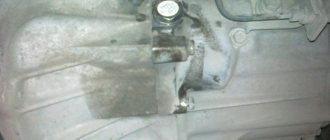Changing the oil in a car's manual transmission
The transmission fluid in an automatic transmission also serves as a working fluid that transmits torque.
In diesel tracked vehicle engines, transmission fluid pressure also creates the torque that turns the crankshaft for ignition. The manual transmission is not equipped with either an oil pump or a torque converter. The question arises what function does the oil perform there? In fact, there are three such functions:
- Lubrication.
A car's gearbox contains gears that are meshed into gears. Accordingly, for a smoother operation and reduced wear of the teeth by reducing friction between them, lubrication is necessary. The lubricant also removes wear products from the contact zone - small chips and metal particles. - Protection.
Oil covers the surfaces of parts with a protective layer, protecting them from corrosion and oxidation, reducing friction and thus extending the life of the entire engine. - Partial heat removal.
When the car moves, the lubricant in the gearbox heats up to an average of 150 degrees Celsius. In the contact area of the gears, the temperature can reach 300 degrees. The oil washes the gears and lowers this temperature slightly.
So, a small volume of lubricating fluid in a manual transmission (approximately 2.5-3 liters) can generally significantly increase the service life of the transmission.
It is advisable to change the oil in a car's gearbox in the fall, regardless of the reason (suspicion of malfunctions, extraneous noise, planned replacement, etc.). The fact is that in winter the gearbox experiences much heavier loads. Automatic transmissions, which are the most sensitive to these loads, most often fail in winter.
If you purchased a used car with high mileage, you even more need to change the transmission fluid in it, and the higher the mileage of this car, the more important it is to replace it as soon as possible. It is unknown how often and to what extent the transmission fluid was actually changed by the previous owner.
Before draining the old oil, it should be warmed up. To do this, it is enough to drive about 5 km by car. Warmed grease becomes less dense and easier to drain. But you shouldn’t drain the fluid immediately after running the car - the lubricant is still too hot. To avoid getting burned, it is better to wait a few minutes until the oil cools to an acceptable temperature.
Procedure for replacing transmission lubricant:
- place the car on the inspection hole and secure the wheels with shoes;
- to make it easier to drain the used oil, eliminate the vacuum inside by unscrewing the filler plug on the other side, and at the same time check the integrity of the sealing ring on the plug - it may need to be replaced;
- carefully unscrew the drain plug, being careful of the hot liquid, drain it into the prepared container, then tighten the drain plug;
- arm yourself with a syringe, fill in fresh oil to the lower edge of the filler neck and close the neck tightly with the lid - to avoid oil smudges, it is better to underfill slightly rather than overfill.
Content
- How often should you change the oil in a manual transmission?
- What signs indicate the need to change the oil in a manual transmission?
- Work order
- Offer from JSC Obninskorgsintez
Changing the oil in the gearbox is carried out to maximize the service life of this unit, which is rightly considered one of the most important mechanisms of the car. The functions of oil in automatic transmissions and manual transmissions are somewhat different. In the first case, the lubricant plays the role of a working fluid, replacing the clutch pedal and controlling the operation of the box itself; in the second, the transmission fluid responds:
- for lubrication of parts that come into contact. The gears of the mechanism are constantly interlocked with each other, so a means is needed to reduce their friction. The lubricant slows down the wear of elements and removes metal shavings from the working area, which can act as an abrasive;
- protection of washed surfaces from corrosion and oxidation processes;
- cooling the unit. While the machine is moving, the temperature at the gear contact points reaches 250 °C. At the same time, the oil does not heat above 150 °C, absorbing excess heat.
Stages of work
Why change the oil in a manual gearbox
1. Drain the oil:
- set the selector to neutral mode, raise the handbrake, put the car in a pit or lift it on a lift;
- Place a container directly under the drain plug to catch the old oil;
- dismantle the pan and remove the sealant and remaining oil;
- remove the filter, first placing a waste container under it.
2. Treat the surface of the pallet:
- Wash the tray together with the magnets with gasoline using a brush;
- wipe with a lint-free cloth;
- if it is necessary to replace the filter, it can be done at this stage;
- if the part remains, it must be treated with gasoline.
3. Place the pallet:
- degrease the area where the tray will be installed;
- change the gasket, apply a sealing compound to the joint areas;
- install the pan and tighten the bolts.
4. Pour in oil (using a funnel, pour in the same amount of liquid that was drained).
5. Push in and add lubricant (help will be needed at this stage):
- disconnect the hose, which is located on the left (in the direction of travel) and serves to cool the oil;
- place one end in the prepared container;
- put the gear in neutral, raise the handbrake, start the engine;
- the new oil will displace the old one (when fresh transmission fluid appears, you need to measure the drained volume for subsequent refilling into the system).
6. Check the oil level (this should be done, focusing on the hot and cold marks; it would be better to underfill a little than overfill).
How to change the oil in a manual transmission
When to change the gearbox oil on a VAZ-2114: after how many km?
Changing the fluid in a manual transmission is a simple procedure that can be done independently.
To independently replace the transmission fluid in a manual transmission, you will need a lift or an inspection pit, or in extreme cases, an overpass.
For some high-clearance vehicles, the replacement can be done on a level surface by simply crawling under the vehicle.
Tools and materials you will need:
- container for draining waste liquid;
- large syringe;
- funnel;
- wrenches or ratchet heads to match the diameter of the drain and oil filler plugs, engine or manual transmission protection bolts;
- sealing ring for the oil filler neck (if the vehicle has significant mileage or was operated in difficult conditions);
- transmission fluid in a volume no less than that specified by the manufacturer.
The main stages of replacing the working fluid in a manual transmission:
1) It is necessary to drive 10-20 kilometers to warm up the fluid in the box. After heating, it will become more liquid, easier and faster to merge.
2) Place the car on a lift or inspection hole, secure it with a hand brake or anti-recoil devices. Changing the fluid must begin no later than 10 minutes after turning off the engine to maintain a thinner oil texture.
3) If it interferes, remove the engine/gearbox protection. Place a container for waste liquid under the drain hole. Unscrew the oil filler plug or pull out the dipstick (depending on what is available) to facilitate draining. Check the condition of the gasket and replace if necessary.
4) Unscrew the drain plug on the crankcase and drain the oil into a container. The fluid must be transparent and free of impurities, otherwise diagnostics of the manual transmission is necessary to determine the reasons (increased wear, overheating, etc.). After the liquid stops dripping from the drain hole, you need to tighten the plug.
5) If there is a dipstick, liquid is poured into the oil filler neck through a funnel. The oil level should be controlled by the dipstick (located between min or max, or in the middle between other inscriptions).
With other manual transmission designs, liquid is poured into the neck of Zhanna using a large syringe, making sure that its level is not higher than the lower edge. Filling the liquid should be stopped when it starts to drip.
6) Insert the dipstick into place or screw on the oil filler cap. Reinstall the protection. Start the car and drive a certain number of kilometers in different gears to fill the mechanisms and distribute fluid through the manual transmission.
7) Check the level of working fluid in the manual transmission, top up if necessary.
The manual transmission is a reliable unit, despite the complexity of the device. It is possible to significantly extend its service life by timely replacement of transmission oil suitable for operating conditions with control over its color and the presence of inclusions.
It is necessary to regularly check the fluid level in the manual transmission, since operating the unit with an insufficient transmission oil level will significantly shorten the operating period and speed up repair of the transmission.
Is it necessary to change the oil in a manual transmission?
When to change the oil in the box: list of models
This is a highly debated issue - after all, many manufacturers claim that the oil in their gearbox is filled for the entire service life of the car! What they mean by this “service life” is another matter. Try to find out at your leisure what the service life of a modern car is. There is no official data on this matter, this parameter is not indicated in the technical specifications (the warranty does not count), and in a car dealership, when buying a car, in response to such a question, they will either throw up their hands in confusion, or will passionately prove that the car will serve your grandchildren (depending on the honesty of the seller). In general, according to unspoken European and American standards, a car can and should even be sold for scrap if it has traveled 35 thousand kilometers per year for seven years. “Seven years and 245 thousand kilometers? So it’s almost a new car!” - many Russian car owners will exclaim. So the standards for the service life of cars in our countries and, perhaps, mentalities are quite different.
Is it necessary to change the oil in a manual transmission?
Now about more objective reasons for changing the oil:
- Despite the fact that on most modern cars the gears are made very accurately and firmly, wear has not been canceled. After a certain time, the oil will be filled with wear products - but the “mechanics” do not provide a special filter for transmission oil, accordingly, all these products are constantly in the box, which only increases wear.
- Oil tends to lose the effectiveness of its primary function (lubrication) after some time. Yes, this requires a fairly long mileage (from 150 to 250 thousand kilometers, depending on your driving style and the quality of the car), but sooner or later it will darken and include a large number of impurities, shavings, etc.
- At constantly high temperatures (mentioned above) and during friction, oil, especially old oil, begins to foam. And foamed oil loses its lubricating, protective and heat-dissipating properties (and in automatic transmissions it stops transmitting torque, which makes it impossible for the car to move at all). As a result, the main gear may “lift up”.
To prevent foaming from occurring, a special set of additives is added to the oil. However, they also lose their properties over time.
- When transmission elements wear out significantly, the driver may hear an incomprehensible noise coming from the box. This hum is heard especially well when switching. If noise appears, it is urgent to disassemble the box, check the wear of its elements and, of course, change the oil.
After changing the oil, car enthusiasts notice: gear shifting becomes softer and smoother, with less knocking and noise. This is due to the fact that fresh oil lubricates the parts much better.
The need to change the oil
So, we figured it out - it is necessary to change the oil. The frequency of oil changes in manual transmissions and its order are issues that deserve special attention.
What kind of oil should be poured into an automatic transmission?
Automatic transmissions are filled with synthetic, semi-synthetic or mineral oils. The main difference from lubricants for manual transmissions is the inscription ATF on the label. ATF stands for "Automatic Transmission Fluid".
Attention! ATF is translated into Russian as “Automatic Transmission Oil”.
In the manual for the automatic transmission, the manufacturer usually indicates the name of the original lubricant. If a similar transmission cannot be found in the city, then analogues are added.
Sometimes the manufacturer indicates the name of the oil on the dipstick between the words “Add” and “Full”; if the name is not there, look in the instruction manual.
The following oils are added to the automatic transmission of many vehicles:
- Toyota ATF IV;
- Mobil 3309;
- Mercon V;
- Toyota WS and others.
Read
Complete and partial do-it-yourself oil change in an automatic transmission Toyota Corolla E150/E120 body
There are special transmission fluids for CVTs. Then the labels say CVT Fluid. Almost all lubricants that are added to automatic transmissions are red. When replacing with an analogue from an original or an original from an analogue, a complete oil change is done in the automatic transmission. I write how to do it for each car model in a section specially created for this.
There is no need to mix oils from different manufacturers. They have different viscosities and active substances; when combined, the latter can react. The oil foams and loses the properties intended for automatic transmissions.
As a result, the car owner will send the automatic transmission for major repairs after driving a thousand kilometers with such mixed oil. In the worst case, you will have to replace it with a contract one or buy a new machine.
The original automatic transmission oil protects the gearbox from overheating and envelops the metal parts with a dense layer of lubricant. In this way, the parts do not wear out for a long time. The original lubricant also has good cleaning properties. At the time of replacement, she rinses all parts, removing fumes and metal chips from mechanical components.
Changing the gearbox oil
One of the best gear lubricants
It is advisable to plan an oil change after a long trip in a Priora car, so that the gearbox is warmed up. After removing the splash guard of the power unit, you need to clean the crankcase drain, unscrew the drain plug, drain the lubricant into a container and tighten the plug. Then you need to fill the transmission oil strictly to the required level. You cannot use lubricant of low quality or unsuitable for Priora, otherwise noise and crunching will occur when shifting gears. So what kind of oil should you put in the box? This question worries many car enthusiasts, and for good reason. In the market of modern lubricants, it is very difficult to make the right choice. Advertisers offer each of their products, but not all of them are of high quality. Synthetic gear oils can cause leaks through auto gaskets at high operating temperatures, which cannot be said about mineral oils. At low temperatures, the lubricant may become mobile. The higher the viscosity index, the less the oil thickness depends on temperature conditions and can be used at any time of the year. In summer, it is necessary to lubricate transmission units at high temperatures, and in winter, to promote safe rotation of gears at low temperatures. Approximate temperature ranges for all-season transmissions:
| SAE class | External temperature range, °C winter/summer |
| SAE 75w-80 | -40 to+35 |
| SAE 75w-90 | -40 to +35 |
| SAE 80w-85 | -26 to +35 |
| SAE 80w-90 | -12 to +45 |
In this table, gear oils are classified by quality. The letters indicate the quality and area of application of the lubricant, and the numbers indicate the temperature regime. Temperature limits when using synthetic materials expand, which mineral oils are not capable of. When oils are used in transmissions, changes occur in their physical composition.
The technician replaces the lubricant in the gearbox
The mineral base oxidizes faster than the synthetic base and therefore ages earlier. Mineral oil needs to be changed more often. The wear of transmission units will be uneven. Semi-synthetics are the child of synthetics and mineral water. Some properties have been improved and the price has been reduced. Synthetics are an advance in comparison to mineral oils. Their physical and chemical properties are more uniform.
All these lubricants belong to the same technical group and can be selected by each car enthusiast at his own discretion. Individual assessment of products, payment for work on changing them, the desire to keep transmissions in working condition for as long as possible - all this will help you choose gear oil for a Priora car produced by AvtoVAZ
When purchasing a car, every driver should carefully read the Priora Operation Manual, where you can find the recommended brands of oils for the car and their characteristics
When choosing a lubricant for Priora, pay attention to the climatic conditions and intensity of use of the machine. Conclusions:
- if it is recommended to fill a Priora car with oil of a certain viscosity, this is what you should do, listening to the advice of AvtoVAZ specialists;
- To maintain the warranty on Priora, the gear oil in the gearbox must be mineral or semi-synthetic;
- high-quality lubricants can be purchased from official dealers;
- When choosing gear oil, always read customer reviews;
- never use oil additives; high-performance lubricants are the best solution for Priora.
Have a nice trip and don't forget to make the right choice!
How to extend the service life of a gearbox
Like any mechanism, the gearbox requires special attention, high-quality maintenance and timely maintenance. To extend the “life” of the unit, it is recommended:
- operate the car (if its units are not tuned) in normal mode: without sudden acceleration and braking at a maximum speed of 110-120 km/h;
- comply with the manufacturer's requirements for changing gears: in a manual transmission there must be a smooth release of the clutch, in an automatic transmission - compliance with the rules for using the selector;
- every 10 thousand km, check the oil level in the gearbox;
- fill only with lubricant recommended by the manufacturer;
- Change the transmission oil within the time limits specified in the instructions.
The process of changing the oil in a manual transmission
Changing the oil in a Hyundai Solaris manual transmission is quite simple with your own hands. The process is a little similar to changing the oil, but has some subtleties and nuances of the procedure. So, let's start changing the oil in the Hyundai Solaris manual transmission:
In fact, it would seem that everything is simple, like all cars, two plugs, drained and filled, but no. But that’s not about that now. We buy oil.
- Remove the engine protection.
We change the oil in a manual transmission on a Hyundai Solaris. To do this, we place the car on an overpass or on a lift. Then unscrew the protection. - We are looking for the drain and fill plug.
- Drain the oil.
Be sure to buy 2 liters of oil. Little by little we begin to unscrew the oil drain plug. The mechanics contain approximately 2 liters of oil. - Why two liters?
1.9 liters were drained from the car. Also, at the same time, slightly unscrew the plug where we will fill the oil, but not completely. - Having tightened the drain plug, we move to the bay. Next, we place a previously prepared container under the oil drain plug, now unscrew it completely and drain the oil. At the same time, unscrew the oil filler plug. We wait until the oil drains.
- To fill the oil, unscrew the filler plug.
After the oil has completely drained, tighten the bottom plug. - Using the control screw, we measure the oil level in the box. We begin to fill the oil into the upper (filler) hole. Using a syringe or making a device using a funnel and a piece of hose. We tighten the plug.
- Everything is ready and the oil has been changed, now we put everything back together as we took it apart. It is worth noting that for orientation purposes, so as not to pour in more than 1.9 liters. The gearbox has a level. After filling the oil, we begin to slowly unscrew the bolt that is responsible for controlling the oil level in the box... ... if the oil flows, this may mean that the level is set, otherwise the oil will need to be filled to the required level. Then we tighten the bolt back and the procedure for changing the oil in the Solaris manual transmission can be considered complete.
Choosing Hyundai Solaris oil
It is recommended to fill a manual transmission (5-speed or 6-speed) with gear oil with a viscosity grade of 75W-85 or 75W90 Gl4/GL5. To replace, you need to purchase 2 liters of oil; the box will take approximately 1.8 liters. Here is a list of oils that are exactly suitable for the Solaris gearbox: Hyundai MTF 75W-85 Gl-4 - considered the original Shell Spirax S5 ATE 75W-90 GL4 GL5.
Why do you need to change the oil in the box?
The automatic transmission oil needs to be changed for the following reasons:
- loss of chemical properties;
- loss of technical and technological properties. Since the automatic transmission parts heat up, the oil also heats up, which means it loses its original properties;
- loss of lubricating properties.
All of the above indicators are reasons for changing the oil and you should not allow at least one of them to lead to damage to the parts located in the gearbox, since changing the oil is cheaper than changing the entire unit.
Recommendations
The manufacturer recommends pouring only original oil into the Hyundai Solaris manual transmission because:
- it is designed specifically for this type of automatic transmission and vehicle;
- has a special chemical structure that protects parts;
- the technical and technological properties of the oil meet the plant standards;
- prevents rapid wear of parts.
The oil in the gearbox is designed to cool the elements and lubricate them, but due to heating it loses its original properties, which is the reason for replacing it.
Conclusion
Having considered the process of replacing and selecting oil, it is worth noting that in this case the manufacturer of the Hyundai Solaris is right that it is better to pour original oil, even though it is more expensive. You should not skimp on protecting manual transmission elements and neglect all technical safety measures.
Transmission oil change interval
If you do not change the lubricant in time, it will lose its properties. This leads to overheating. And overheating, in turn, destroys rubber seals, gaskets, and clutches. Destruction of the breather leads to oil leakage. Destruction of the clutches leads to clogging of the filter device with the adhesive base.
Read
The best ATF Dexron 3 oils for power steering and automatic transmission
This is why changing the oil is so important. An untimely change will lead to repair of the automatic transmission. Although many manufacturers say that the oil on modern automatic machines does not need to be changed, do not listen to them. This is a marketing ploy. The more automatic transmissions are broken, the more money they will make by selling a new one.
So, if you just purchased a car with an automatic transmission or a CVT, then you don’t have to change the oil in the automatic transmission until you’ve driven 150,000 kilometers. Then do a full shift of working out.
After the first full change, the oil is changed at the following intervals:
- 30 thousand kilometers – partial change;
- 60 thousand kilometers - full.
If you change the lubricant at a service station, they will leave a note on the automatic transmission at which kilometer you need to change the lubricant.
Is it necessary to change the oil in the mechanic's box?
Any car owner knows that stable operation of components and mechanisms is possible only if you regularly change the oil in them. We are talking not only about the engine, but also about the gearbox. You can find a lot of information on the Internet about the frequency of changing the lubricant in automatic transmissions. The most optimal period is considered to be 50–60 thousand km. Not much is known about how often to change the fluid in manual transmissions. Not all owners of cars with a manual transmission understand the optimal period for changing the lubricant, at which the transmission would serve for a long time without forcing the driver to think about repairs. Many are completely convinced that this procedure is not necessary and are convinced that the “mechanics” will serve without repair for many years with oil once filled. Moreover, not all car owners have any idea what kind of composition is poured into the box. But the “mechanics” itself can remind you of the need for replacement, starting to emit a characteristic howl in the first two gears after 120–150 thousand km. This will mean it's time to change the lubricant.
In fact, the fluid is poured into the manual transmission for its entire service life, until the unit fails due to poor quality of the lubricant. In this case, it is necessary to understand the very concept of “service life”.
Today it is already common knowledge that almost all vehicles sold in Russia are developed in other countries. And there, on average, cars last less, and drivers change them more often, out of desire, and not out of necessity, when it is no longer possible to drive an old car. There are cases when used, but still usable cars with minor defects are sent to a landfill. The driver buys a new car, drives it for up to 5 years until the warranty expires, and exchanges it for the next car. Abroad, this period can be called service life.
In Russia the situation is different. Here, especially in the provinces, many cars made in the 1970s are still in use. The cars would not have lasted so long if the oil in their gearboxes had not been regularly changed, since spare parts for these outdated models have not been on sale for a long time.
Thus, if service life means a 5-year period with a mileage of 100 thousand km, then lubricant is actually poured into the “mechanics” for this entire period. In cases where the car is expected to be used for a much longer period of time, it is better to change the oil every 2–4 years or every 50 thousand km, depending on which limit comes first.
Reviews from car owners about whether it is possible to fill automatic transmission oil into a manual transmission
“Under no circumstances should you pour standard lubricant into an automatic transmission. The automatic uses oil-based ATF. You are not comparing hydraulic fluid and engine oil. You can fill a manual transmission with semi-synthetic.”
“The viscosity of transmission fluid for automatic transmissions is much lower compared to mechanical lubricant. Some craftsmen manage to pour this kind of oil into shock absorbers.”
“Of course, some people put ATF in the manual transmission. For example, the Opel Cadet (now Nexia) had Dexron poured into its manual transmission. I don’t think it’s necessary to do this.”
We recommend
“What’s not clear to me is why use expensive non-original lubricant instead of cheap oil that is specially used for mechanics? Maybe the driver thinks it will freeze? In this case, it is better to purchase ESSO semi-synthetic transmission fluid and drive safely even in cold weather.”
“Transmission fluid contains antifriction additives. They are absent in ATF, so the viscosity is different. If you pour Dexron into a manual transmission, the gearbox elements will simply be erased.”
Source
Changing the oil in a manual transmission: when and why the lubricant needs to be changed
Let's start with the fact that the “mechanics” is a reliable unit. First of all, the relative simplicity and time-tested design allows you to operate a car with this type of gearbox for at least 150-200 thousand kilometers without repairing the gearbox.
However, you need to understand that this is only possible if the unit is serviced in a timely manner and does not experience serious loads. In other words, the driver is experienced and knows how to drive a manual car correctly. Also, a responsible owner constantly monitors the condition of the transmission oil, eliminates minor faults in a timely manner (leaks of oil seals, gaskets and gearbox seals, replacing the clutch at the slightest sign of wear, adjusting the rocker, etc.).
As for maintenance, for a manual transmission this procedure involves changing the transmission oil. Since the oil in a manual transmission is not a working fluid, the main purpose of replacing it is to reduce wear of parts to increase the overall service life of the unit.
Also, in parallel with replacing the lubricant, the manual transmission pan is cleaned of dirt and deposits, and the magnets on which metal shavings accumulate as a result of natural wear and tear of the gearbox parts are cleaned.
At the same time, experts recommend replacing every 50-60 thousand km or once every 4-5 years (whichever comes first). If the car is used in difficult conditions (constant transportation of goods, towing a trailer, jerky driving with changes to lower and higher gears at high revs and speeds, driving in mountainous areas, etc.), then the replacement interval should be reduced by a third.
Certain signs may also indicate the need to change the lubricant in the mechanic's gearbox. For example:
- during operation of the gearbox, extraneous noise and/or vibration appears in the gearbox;
- gears may be difficult to engage until the box warms up in winter;
- It is difficult to shift gears into hot gears; gears are engaged with a crunch;
First of all, in such a situation, you need to pay special attention to the amount of lubricant in the gearbox, that is, check the oil level in the manual transmission. At the same time, the quality of the lubricant should be assessed. If everything is in order with the level, this does not mean that the unit does not need to be serviced
Although the gear oil in a manual transmission does not heat up as much as in automatic transmissions or CVTs, the lubricant is still subject to oxidation, aging and loss of a number of useful properties. As a result, the viscosity characteristics change, the additives in the oil are used and may precipitate.
If everything is in order with the level, this does not mean that the unit does not need to be serviced. Although the gear oil in a manual transmission does not heat up as much as in automatic transmissions or CVTs, the lubricant is still subject to oxidation, aging and loss of a number of useful properties. As a result, the viscosity characteristics change, the additives in the oil are used and may precipitate.
In the process of lubricating gears, shafts and other gearbox parts, transmission fluid also actively accumulates wear products (metal shavings). Regular heating and cooling can also lead to the accumulation of condensation in the oil, etc.
It is not difficult to guess that if, without other visible reasons, the quality of the gearbox has deteriorated and the above symptoms appear, this indicates that the functionality of the oil in the gearbox has decreased significantly, while the overall wear of the unit has increased significantly.
Let us also add that much will depend not only on the level and “freshness” of the lubricant, but also on how correctly the oil in the gearbox is selected. In other words, the use of transmission oil that is not suitable for tolerances and properties can quickly destroy a fully functional unit.
Consequences of overflow
When using a car for a long time, its owner may encounter problems such as difficulty shifting gears. This is often due to the fact that the filled oil has lost its working functions. It is imperative to check the gears and transmission teeth.
If, while adding oil to the automatic transmission, it overflows, this will negatively affect the functioning of the high-speed box. Due to foaming, the components of the transmission will not be well lubricated, will begin to experience heavy loads, and will break. You need to add liquid of the brand that was filled earlier. For each version of the car, the amount of oil added is individual.
Thus, one of the types of automatic transmission repair is adding new gear oil. This procedure can be carried out independently. How to add oil to the box? Especially for this, it is necessary to warm up the vehicle, arm yourself with a filling syringe, and prepare new fluid. It is possible to determine the lubricant level using a dipstick. Oils differ in viscosity and temperature. The car owner should take this into account when making a purchase.
Key Caveats
Every mixture in your car should be changed at regular intervals. Everything wears out. Yes, I even mean brake fluid, antifreeze and power steering oil. If you want your car to last a long time, change your fluids regularly.
Most manual transmissions that have been used in the last 20+ years actually use automatic transmission oil as their lubricant. They are cheap and easy to change if something happens.
To replace, take a simple hand pump and pan and do it yourself. You can find a video on YouTube on how to do this.
It is worth considering that most manual transmissions do not have a filtration system, not to mention pressure lubrication.
How to change the oil yourself
Changing the engine oil yourself takes place in 5 stages:
- Preparing tools and car.
- Drain.
- Replacing the filter.
- Bay
- Checking the level.
The whole process takes 30 - 60 minutes.
What you need before replacing
To change the engine oil yourself, you will need:
- key for unscrewing the underbody protection;
- socket wrench for the pallet plug bolt;
- old belt from the generator for removing the oil filter;
- container with a wide neck for draining;
- fresh motor oil;
- new oil filter;
- sealing washer or new drain bolt;
- clean rags;
- rags;
- funnel;
- gloves.
Before you start, check your car's manual to find out how to remove the protection, where the pan plug is located, how much oil is needed, etc. After theoretical preparation, start practice.
Instructions for changing engine oil
Proper oil change begins with preparing the car. After inactivity, the lubricant becomes viscous and will take a long time to drain. To restore its fluidity, warm up the engine to operating temperature. This may take 10 minutes.
Park the machine on level ground. For ease of work, you can use a lift or overpass. Turn off the engine. Wait 10 minutes for the grease to drain into the pan.
In general, the procedure for changing the oil looks like this: drain the oil and fill in new oil in the amount specified in the service book. However, there are nuances that should not be forgotten, so we will consider the replacement process in detail:
- If your vehicle has an underbody guard, unscrew it first.
- Find the pan plug. Loosen the bolt using a wrench.
- Place a container to drain the old lubricant.
- Carefully unscrew the plug by hand until hot oil flows out.
- It may take about 20 minutes to drain completely, depending on the volume and viscosity of the lubricant.
- Tighten the bolt with the new sealing washer with the required torque to avoid leaks.
- Open the hood. Unscrew the oil filler neck.
- Pull out the oil dipstick.
- Unscrew the oil filter using an old strap around it. Clean the mating surface from old gasket and dirt.
- On the new filter, lubricate the rubber band with engine oil to prevent it from curling up during installation. Screw on the filter.
- Place a funnel into the oil filler neck. Pour in fresh composition in the required volume.
- Check the oil level periodically if the canister does not have a volumetric flask.
- We start the engine so that fresh lubricant passes through the new filter. We jam it.
- We wait until the composition drains into the pan and check the level.
- Screw on the neck cap and put the protection in place.
The above method refers to a complete manual replacement. Some car services offer another option: change the engine oil using a pneumatic unit. The choice of replacement technology - manual or hardware - depends on the design of the motor, its serviceability, and the experience of the technician. For example, the pans of some internal combustion engines have a complex shape, and the crankcase can only be completely drained through the drain plug. If the filter is installed under the crankcase protection, you still have to crawl under the car. But for the sake of objectivity, we will also outline the positive aspects of express replacement.
Express oil change
Hardware drainage is performed through a dipstick pipe. A device hose is inserted into the hole, through which the lubricant is sucked out of the pan due to vacuum. The process takes no more than 10 minutes.
Some devices are capable of cleaning the engine by displacing the remaining lubricant from the line with compressed air. The procedure can be useful when buying a used car. When you are not sure that the car was properly serviced.
What is needed for an express engine oil change:
- suction apparatus;
- a tube of suitable diameter and length (selected for a specific engine);
- fresh oil.
Sequence of operations for express replacement:
- Take out the dipstick. A suction tube is inserted into the hole so that it reaches the crankcase.
- The other end of the tube is connected to the fitting of the device and the old composition is pumped out.
- After pumping, take out the tube.
- Pour fresh lubricant through the filler neck.
- Check the level.
What are the advantages of express replacement:
- Saves time that is usually spent on dismantling the protection, unscrewing the plug and draining the lubricant.
- There is no need to buy a new sealing washer or bolt for the drain plug every time.
Changing the oil in a manual transmission
To change the oil in a manual transmission, it is recommended to use only new lubricant. This is the key to the reliability and durability of the car transmission. Before changing the oil in the gearbox, you need to place the car on an overpass or place its front part above a special inspection hole, where free access will be provided. This is caused by the inconvenient location of the box and drain plug - under the bottom of the car.
Experienced auto mechanics advise draining the old oil immediately after driving the car. In this case, the heated lubricant flows faster along the inner walls of the crankcase, changing the oil in the gearbox will be much easier and faster.
How to add oil to an automatic transmission
As a rule, the need to add oil to the automatic transmission is determined at the moment when the ATF level is checked. The level is checked on a fully warmed-up gearbox, while the engine must be running (in most cases, since some automatic transmissions require checking the level with the engine turned off, which can be specified separately in the manual).
To warm up the machine, you first need to drive 10 to 15 km before checking, then stop the car on a level surface. The level on most automatic transmissions is checked using a special automatic transmission dipstick.
If the check shows that the oil level is low and the fluid needs to be added, then on cars without an automatic transmission dipstick, you need to do the following:
In case of overflow, the box operates with shocks or jerks, clutches burn out, and other transmission parts wear out. Also, excess oil can be squeezed out through the breather, which leads to oiling of the housing.
How to change the oil in a manual transmission
It is recommended to change the oil in the gearbox in autumn or winter. It is during this period that the unit bears the heaviest load and the probability of its failure is high. An urgent oil change is also required for newly purchased used cars with a mileage of over 60,000 km. The independent procedure for replacing the working fluid in the gearbox consists of several stages.
- We warm up the oil by driving for ten minutes. Placing the car on a specially equipped pit with the wheels secured using “shoes”;
- Unscrew the oil filler plug;
- Remove the drain plug and drain the oil into a container;
- We fill the unit with new oil using a syringe to the lower limit of the “oil filler” neck (be careful not to overfill), tighten the cap (most often you need a new set of cap and o-ring).
If you are not confident in your own abilities, seek help from professional mechanics. Official service centers of FAVORIT MOTORS Group offer a wide range of services for maintenance, diagnostics and repair of cars of any make and configuration. Do not neglect problems with the gearbox, other components and assemblies of the machine, your safety depends on their condition! Transmission oil catalog Ask a question











